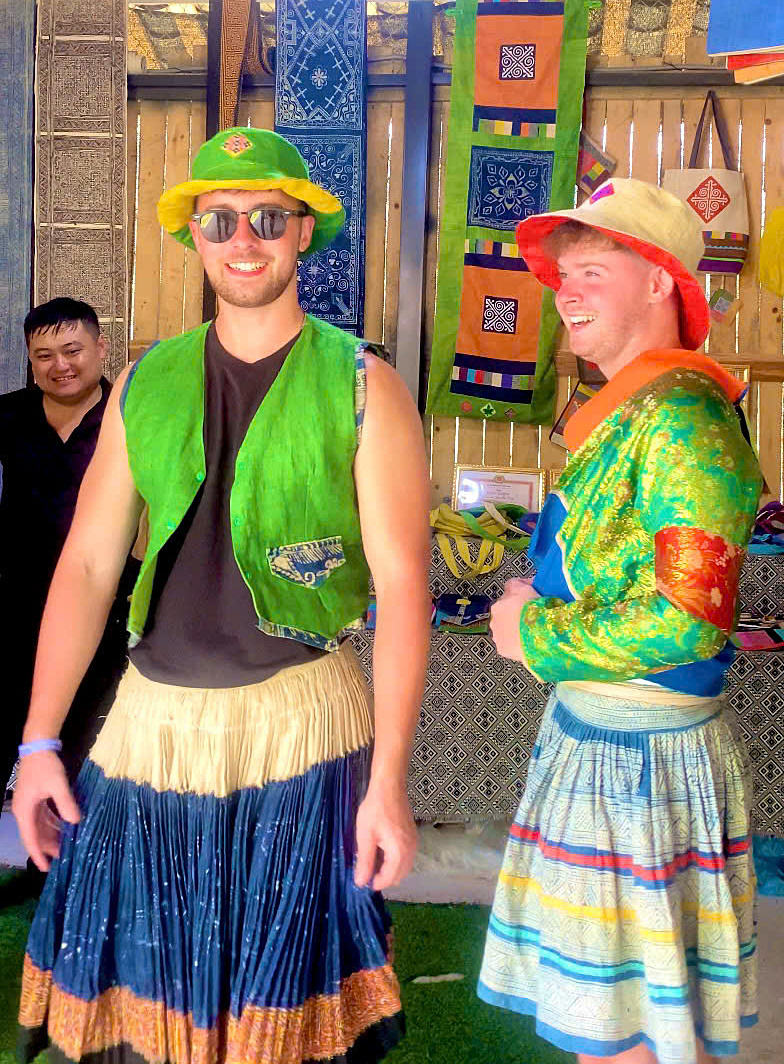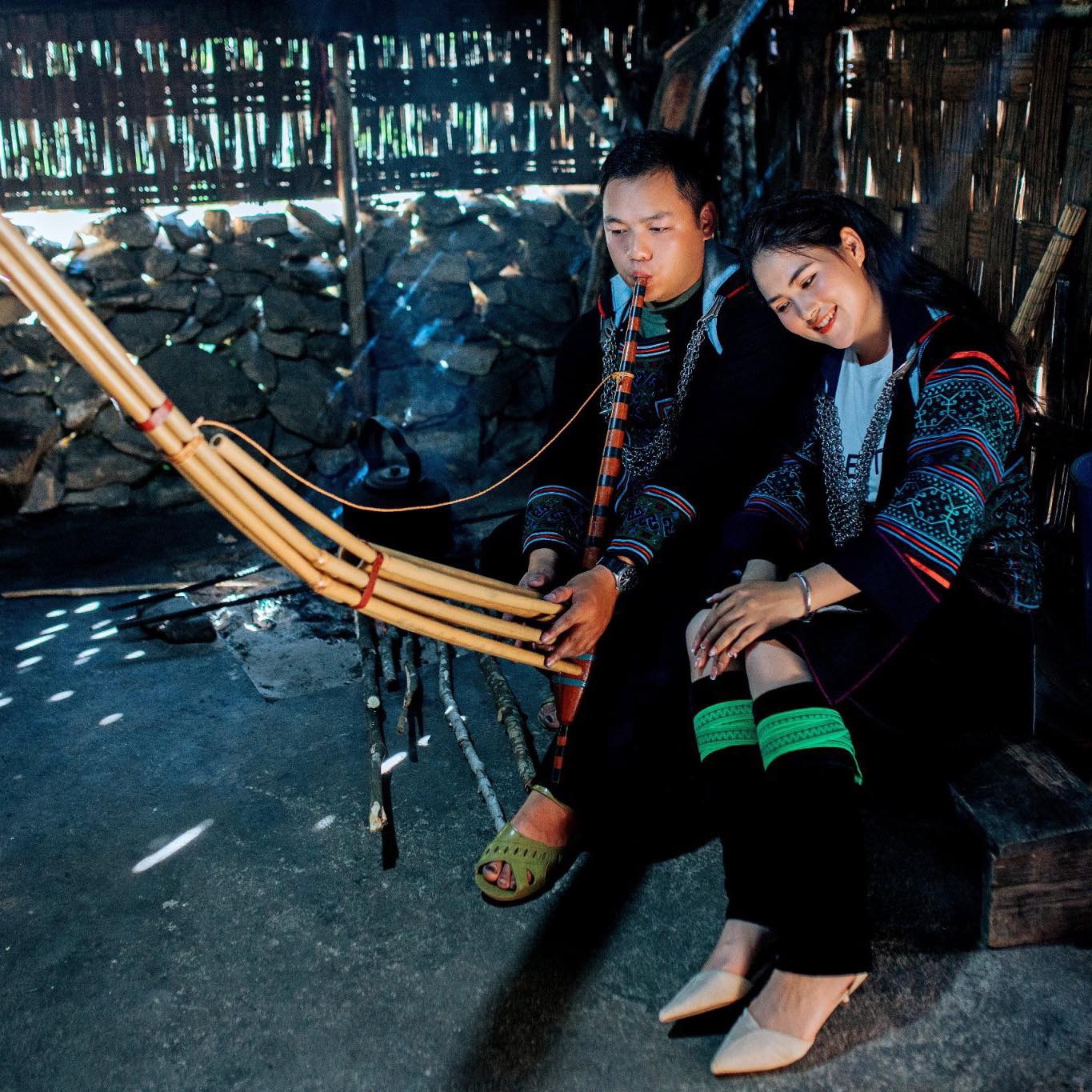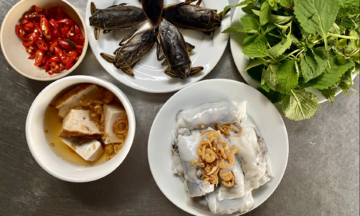Lo A Loi, a 29-year-old Hmong man working in the tourism industry in Sa Pa, noted a rising trend on TikTok over the past six months: male tourists donning Hmong skirts for photos in Ha Giang, formerly part of Tuyen Quang province. Loi considers this practice a cultural misappropriation and urges the Hmong community to protect their heritage.
He attributes this trend to two main factors: ignorance and attention-seeking behavior. "Many understand the cultural significance but encourage tourists, especially men, to wear women's Hmong skirts as a unique gimmick for videos, creating trends and boosting engagement," Loi said.
He added that many Hmong people, including himself, feel offended, as clothing has clear gender distinctions and is deeply tied to honor, rituals, and spiritual beliefs.
 |
A male tourist inappropriately wearing a Hmong skirt in Ha Giang. Screenshot |
A male tourist inappropriately wearing a Hmong skirt in Ha Giang. Screenshot
For the Hmong, traditional attire represents their soul, cultural identity, and ethnic pride. Every pattern, stitch, and piece of fabric embodies historical, spiritual narratives. Socially, the skirt serves as a dowry and a testament to the bride's craftsmanship. Girls learn embroidery from a young age, preparing for their future roles as wives and mothers.
Dr. Tran Huu Son, director of the Institute for Culture and Tourism Application Research, explained that the skirt is a cultural symbol of the Hmong people. It distinguishes between the Black Hmong, White Hmong, and Flower Hmong. Hmong folklore even celebrates the skirt, recounting how the Jade Emperor rewarded the people for offering him a beautiful skirt.
The skirt is primarily associated with women. Men rarely wear it, except for shamans. In daily life, Hmong men may wear similar attire to the Kinh people, but in death, both men and women are dressed in or placed beside a skirt, symbolizing a return to their roots.
Vu Huong, a Hmong author and tourism professional in Ha Giang, believes in preserving and appropriately showcasing traditional cultural values for tourism. She argues that tourism professionals should educate foreign visitors about the historical and cultural significance of the skirt, rather than letting male tourists wear it for amusement.
"These are farcical acts, not cultural exchange," she said, emphasizing that the Hmong skirt is more than just clothing.
 |
Two tourists wearing Hmong skirts. Photo: Jasmine Tours |
Two tourists wearing Hmong skirts. Photo: Jasmine Tours
However, Nguyen Van Tuan, a representative of Jasmine Ha Giang, a company specializing in Ha Giang Loop tours for international tourists, suggests a more open-minded approach. His male clients have worn Hmong skirts for photos, and he emphasizes "they wear it out of admiration and pride." He asserts, "I've never witnessed any disrespectful behavior."
"If wearing local attire is deemed disrespectful, then everything should be placed in a museum," Tuan argues, pointing out tourists' natural curiosity and desire for new experiences in foreign countries.
Representatives from other Ha Giang tour operators echo this sentiment, viewing it as a cultural experience. Modern tourists seek immersive experiences and want to try local life. Therefore, companies often offer opportunities for tourists to try on ethnic clothing or participate in activities like rice harvesting or buffalo herding.
Dr. Son acknowledges that men wearing skirts "generally looks unusual, and if local Hmong people object, tourists should respect their views." However, he encourages open-mindedness if tourists are simply taking pictures without being disrespectful, particularly in the context of tourism.
Dr. Trinh Le Anh, head of the Event Management Department at the Faculty of Tourism Studies, Vietnam National University, Hanoi, warns that male tourists wearing Hmong skirts "for fun" without understanding or proper guidance can easily cause offense.
 |
Loi wearing traditional Hmong attire. Photo: NVCC |
Loi wearing traditional Hmong attire. Photo: NVCC
There's a fine line between appreciation and mockery. When such images go viral on social media as "jokes" or "trends," the Hmong skirt, a symbol of femininity and identity, becomes a prop for ridicule.
Dr. Le Anh recounts his experiences wearing traditional attire in Japan, South Korea, and Bhutan, always within a context of clear explanation, rules, and respect. He never wore women's attire, even for photos.
"Culture isn't for casual cosplay," he stated.
As a Hmong individual, Huong advocates for "cultural openness within limits," avoiding distortions that harm the local community. She notes that the Hmong have modernized their accommodations for tourists but maintains that the women's skirt "is not for men to wear," except in the afterlife. She proposes government policies to protect culture as the foundation of tourism.
According to Dr. Le Anh, balancing the needs of the local community and tourism operators is always complex. For locals, culture is their sacred root, requiring preservation. However, some tourism operators, lacking understanding, may view culture as a "product" to attract tourists. This disparity risks "commercializing identity" or offending the community, reducing them to a "backdrop" for tourism.
He proposes long-term solutions like providing comprehensive training for tour guides and operators, equipping them with in-depth knowledge of local culture. Secondly, local communities need empowerment in designing tourist experiences, from deciding who can wear traditional attire and under what circumstances to how cultural meanings are explained. This goes beyond participation; it's about co-ownership and co-creation of cultural products.
Finally, he urges localities to establish codes of conduct for cultural tourism, providing soft guidelines that educate and guide the behavior of both tourists and tourism professionals.
Tu Nguyen












